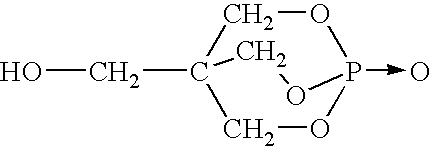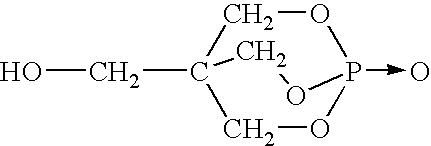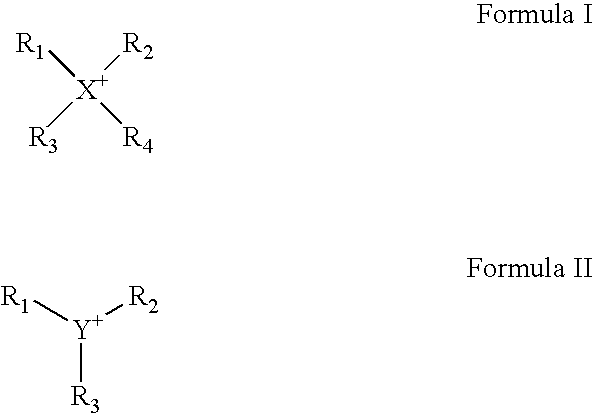Intumescent polymer compositions
a technology of intumescent polymer and composition, which is applied in the field of intumescent flame retardant polymers, can solve the problems of reducing the commercial success of intumescent polymer systems, adverse effects of additives on processing or properties, and reducing the amount of additives, so as to achieve synergistic effect of composition and intumescen
- Summary
- Abstract
- Description
- Claims
- Application Information
AI Technical Summary
Benefits of technology
Problems solved by technology
Method used
Image
Examples
examples 1 to 18
[0050]The following examples demonstrate how the flame retardant performance of a mixture of pentaerythritol phosphate alcohol (PEPA) and melamine phosphate in a 2:3 weight ratio, respectively, can be improved in polypropylene with montmorillonite clay materials. A minimum of 21% of the PEPA:melamine phosphate mixture is needed to obtain a 94V-0 rating in Himont 6524 polypropylene (MF1=6). A formulation of 20% of the PEPA:melamine phosphate mixture and 1% Cloisite 15A (organoclay, Southern Clay Products) also has 94V-0 rating. This indicates that the flame retardant component can be substituted with low levels of clay without sacrificing UL-94 performance. At a 0.8% loading of Cloisite 15A only 19% of the PEPA:melamine phosphate mixture was required to obtain a 94V-O rating, while formulations slightly lower or higher in clay content did not provide a 94V-O rating (Table 2). This demonstrates the necessity of using the clay additive within a well-defined range of loading levels.
[005...
examples 19 through 28
[0056]In the following examples, additive compositions consisting of 48.5% pentaerythritol phosphate alcohol, 48.5% melamine phosphate, and 3% of one of sodium montmorillonite clay A, B or hectorite clay C were blended with polypropylene as noted above and fabricated into {fraction (1 / 16)}″ test bars. Sodium montmorillonite clay A is available from Southern Clay, Inc., grade Cloisite Na. Sodium montmorillonite clay B had the characteristics shown in Table 5 whereas hectorite clay C is characterized as in Table 6.
[0057]
TABLE 5Sodium Montmorillonite Clay BGeneral Description:A specially processed, water-washed sodiummontmorillonite clay.Brightness (G.E.):83-87Viscosity:250-500 cps. (at 5% solids)pH:2% dispersion 8.5-10.5Wet Particle Size:Minimum 99.00% finer than 325 mesh (44 microns)Elemental Analysis:Typical values listed are not to be construed as rigidspecifications(All metals are expressed as oxides, which are complexed in the mineral.)SiO276.05%Al2O316.10%MgO1.47%Fe2O31.68%CaO1....
examples 29 through 35
[0062]The following examples illustrate the effectiveness of various ammonium polyphosphate-based (APP)FR / polypropylene compositions which were prepared and tested as above. The particular ammonium polyphosphate composition employed was a commercially available product which is believed mostly APP, but also contains other additives.
[0063]
TABLE 10Ammonium Polyphosphate (APP)FR / Polypropylene CompositionsExample No.29303132333435FR-1APPAPPAPPAPPAPPAPPAPPFR-2SodiumSodiumSodiumMontmorilloniteMontmorilloniteMontmorilloniteClay AClay AClay A% FR-125242322212019% FR-20.80.80.8% PP7576777878.279.280.2UL-94V-0V-0V-0FAILV-0V-0V-0@ 1 / 16″
PUM
| Property | Measurement | Unit |
|---|---|---|
| weight percent | aaaaa | aaaaa |
| afterglow time | aaaaa | aaaaa |
| formulation | aaaaa | aaaaa |
Abstract
Description
Claims
Application Information
 Login to View More
Login to View More - R&D
- Intellectual Property
- Life Sciences
- Materials
- Tech Scout
- Unparalleled Data Quality
- Higher Quality Content
- 60% Fewer Hallucinations
Browse by: Latest US Patents, China's latest patents, Technical Efficacy Thesaurus, Application Domain, Technology Topic, Popular Technical Reports.
© 2025 PatSnap. All rights reserved.Legal|Privacy policy|Modern Slavery Act Transparency Statement|Sitemap|About US| Contact US: help@patsnap.com



